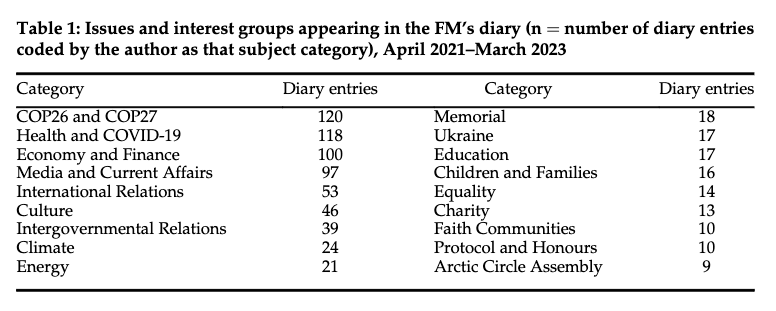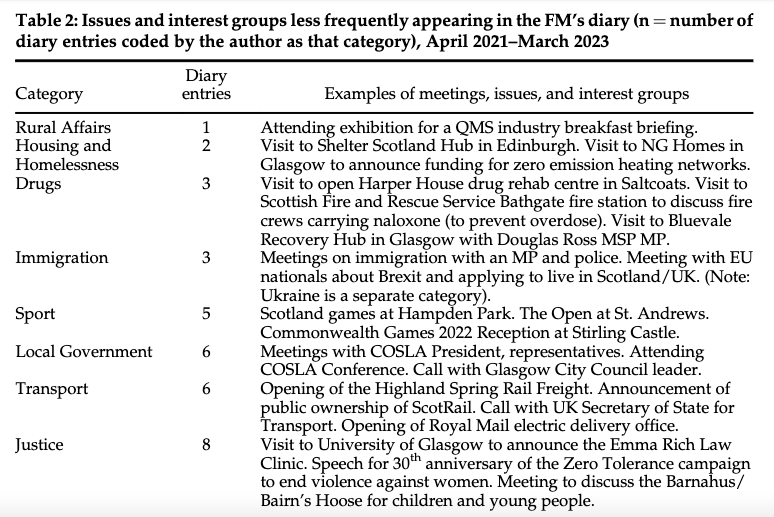| 8 mins read
Analysis of Scottish ministerial diaries is practically non-existent, despite them being routinely made publicly available. I use the conceptual lens of chronopolitics—the politics of time—to consider how Nicola Sturgeon spent her time as an SNP FM in the final years of her leadership. To what extent do priorities which are emphasised in Sturgeon's public and parliamentary communications feature in her diaries? In private and in public settings, to whom and what did she give her time? Who and what may be missing?
Diary entries cover April 2021 to March 2023 – the final two years in which she was FM and SNP leader – and include: visits, meetings, press conferences or media interviews, dinners, receptions, exhibitions, briefings, conferences, phone calls and video calls. These were analysed using the method of content analysis. Diary entries vary significantly per calendar month, with some months having as few as ten entries (July 2022) and some as many as 106 entries (November 2021).
Access is imperative to influence and agenda setting. Cullerton and colleagues suggest ministerial diaries are ‘unique datasets that have not previously been systematically analysed’, while acknowledging important caveats like how diaries ‘do not capture all of the interactions ministers undertake and we have no way of knowing how closely the diaries represent a minister's actual day.’ It is wholly expected that Nicola Sturgeon interacted and met with others in Scottish government, and delegated meetings to other ministers.
Some diary entries have been cross-referenced with three other publicly available resources to gain more information about why they interacted with the FM and the topic of focus: the Scottish Parliament lobbying register; the Scottish government first minister's speeches collection; and the Scottish government FOI disclosure log publications about first ministerial meetings. For the period, there are 100 registered entries of regulated lobbying of Nicola Sturgeon as FM. These are mostly by charities, trade unions, businesses and energy companies. With very few exceptions, professional lobbyists are absent from Sturgeon's diaries and lobbying register entries.
Time, priorities and proximity
Ministerial diaries catalogue more of the backstage of the ‘day job’ of first ministership. Table 1 gives an overview of how Sturgeon's diary entries have been categorised. One of the findings here is that what dominates Scottish news media narratives is not necessarily what dominates the FM's time. Some issues and interest groups cut across both as priorities, while some issues and interest groups are conspicuous by their absence in diaries.

Content analysis shows how the FM's time was spent on what would reasonably and regularly be expected of a national leader in a modern democracy, for example, media interviews, meeting international leaders and visiting dignitaries, navigating the pandemic, and meetings with trade unions and workforce leaders.
Intergovernmental relations
One diary item in this category stands out; the regularity of meetings between the Scottish and Welsh FMs, Nicola Sturgeon and Mark Drakeford, attests to a friendship and savvy political cooperation.
Economy and finance
Of the senior SNP figures most closely associated with the economy and finance over the years, Nicola Sturgeon would not necessarily be the first to come to mind, unlike Kate Forbes and Andrew Wilson. Yet Economy and finance have dominated Sturgeon's first ministerial diary.
Analysis of qualitative information in Sturgeon's diary entries show three clear patterns. First, there are a lot of meetings with bankers, business and financial experts. Second, there are a lot of on tackling the cost-of-living crisis and economic inequalities. Third are regular meetings with trade unionists.
A perception of Sturgeon was that ‘businesses felt that they were at the end of the queue, while her attention was focused on public services and inequalities. Analysis confirm close involvement in the health portfolio, but otherwise contradicts and challenges this view: Sturgeon spent plenty of time interacting with business and focussing on the economy. A salient point from her diaries is that it was often big business and industry bodies. A potential driver of these perceptions in business circles, other than self-interest, is that Sturgeon foregrounded environmental issues (deposit return recycling scheme) and health issues (restrictions on alcohol advertising) which received mixed reactions in those sectors.
Energy, climate and the environment
During her time as FM, a substantial amount of time was devoted to meetings on energy, climate and the environment - the FM spent approximately 24 per cent of the total sample of two years of meetings and engagements focussing on these areas combined. Indeed, the largest of categories in this sample is ‘COP26 and COP27’. For COP26, the international spotlight was on Glasgow and Scotland; adding eighty-three meetings and high-level connections to her other commitments in a calendar month was a strategic choice which permeated into mostly favourable press coverage.
One of the striking features of Nicola Sturgeon's diaries is the time spent on matters that are, under the terms of the Scotland Act, partly or mostly reserved to Westminster. Energy is one of these areas.
Which issues and groups don't get much time?
Some of Sturgeon's stated priorities and Scotland's most prominent public policy problems on which she was pressed in FMQs were not frequent categories in her diary, as illustrated in Table 2. Rural affairs is the least frequent coding category, with one diary entry and making up 0.1 per cent of the total sample.

One of the most politically potent and deeply felt issues on this list is drug policy and drug deaths. Only three diary entries appear to fall within this category. lt falls short of what some Scots might expect in response to a national emergency. Another area which was largely absent was criminal justice and community safety, but these topics were not infrequent or missing from Scottish parliamentary scrutiny and debate, nor from the news media. Finally, there is a notable lack of interaction and close cooperation between leaders of national and local government.
Key insights from first ministerial diaries
Women and children appear as ‘signature’ priorities spanning across different areas of the FM's activities. This includes, but extends well beyond diary entries. Another signature priority across categories is that of books and reading.
As First Minister of Scotland, Nicola Sturgeon spent a proportion of her time focussing on matters that are partly or wholly reserved to Westminster. By contrast, she did not spend much of her time in meetings and engagements on some major political and public policy issues in Scotland which are (partly or wholly) within the powers of devolution. Instead, these were handled by other Scottish ministers. An audience with a national leader can be indicative of priorities and potential for influence—as can its absence.
Need help using Wiley? Click here for help using Wiley






